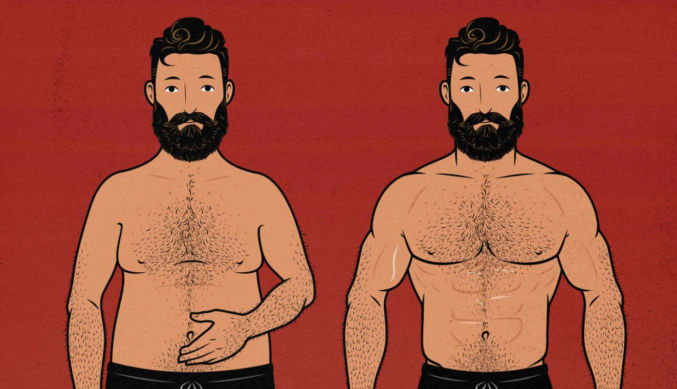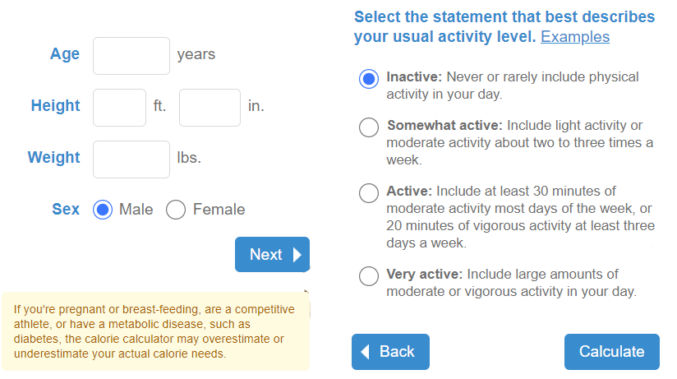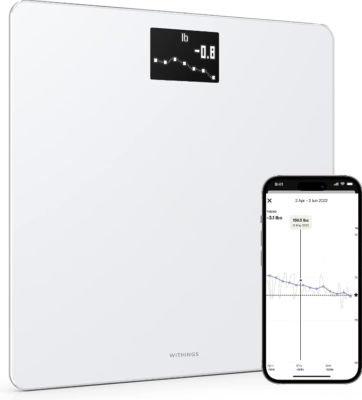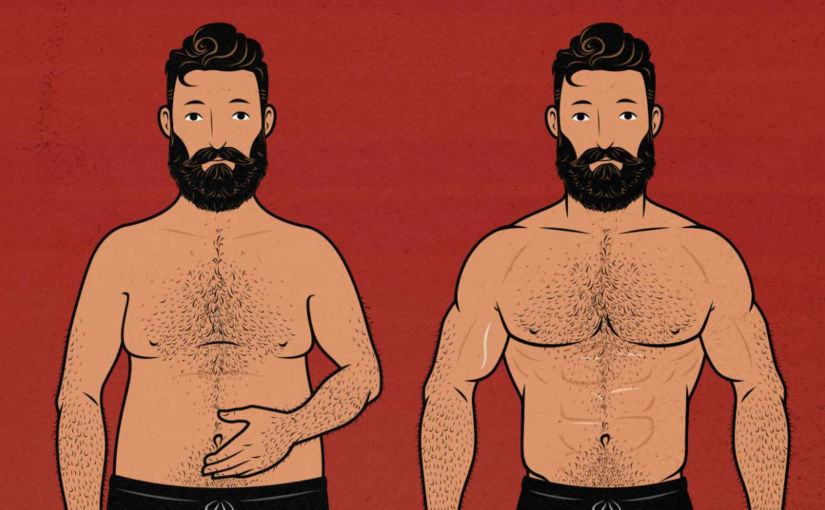
Step 1: Determine Maintenance Calories
Your maintenance calories is the number of calories you consume and burn each day to neither lose nor gain weight. Enter your information in this online calorie calculator by the Mayo Clinic. It uses the Mifflin-St. Jeor equation, which pros consider the gold standard.

For me, my maintenance calories is currently 2650 calories per day.
Step 2: Calculate Calories & Protein to Lose Weight and Build Muscle
Losing Weight (Fat)
In order to lose weight by losing fat, you just need one thing: a net deficit of calories. But you don’t want too large a deficit because then you’ll lose both fat and muscle. You should target a deficit of 5 to 10% of your maintenance calories. You can lose weight by just
- consuming fewer calories without exercising
- consuming more calories but burning extra calories by doing cardio exercises like running
Whether you just rest or you exercise, your net calorie deficit should be 5 to 10% of your maintenance calories. For me, this value is currently between 2385 and 2517 calories.
Gaining Muscle
In order to gain muscle, you need 4 things:
- a net surplus of calories
- strength training until failure
- sufficient protein consumption
- rest (minimum 7 hours a day)
For the calories, you don’t want too large a surplus because then you’ll gain both muscle and fat. You should target a surplus of 5 to 15% of your maintenance calories. For me, this value is currently between 2782 and 3047 calories.
For the protein, you should target consuming 1 gram of protein for each pound of body weight. So, if you weigh 180 lbs, you should consume 180 grams of protein.
The calorie (energy / fuel) surplus is needed to rebuild the muscle you’ve broken down during strength training. Breaking down muscle fibers only happens if you train to failure. The large protein consumption is needed because muscles are made of protein. Muscle (protein) synthesis occurs while you’re sleeping, which is why it’s necessary to sleep enough after strength training.
Target Calorie & Protein Summary
| Day | Calorie | Protein | My Target |
|---|---|---|---|
| Rest or Cardio | 5-10% deficit | Any amount | 2385-2517 calories, any protein |
| Strength Training | 5-15% surplus | 1 gr / lb of body weight | 2782-3047 calories, 180 grams of protein |
Studies show that consuming high amounts of protein while in a calorie deficit can preserve muscle mass and accelerate fat loss. Therefore, if possible, consume a lot of protein daily, not just on strength training days.
Step 3: Make a Weekly Schedule
Your weekly schedule would be a combination of resting days, cardio days, and strength training (weight lifting) days. Here’s an example.
| DAY | ACTIVITY | CALORIES |
|---|---|---|
| Monday | Rest | Calorie Deficit, Extra Protein |
| Tuesday | Strength Training | Calorie Surplus, Extra Protein |
| Wednesday | Cardio | Calorie Deficit, Extra Protein |
| Thursday | Rest | Calorie Deficit, Extra Protein |
| Friday | Strength Training | Calorie Surplus, Extra Protein |
| Saturday | Cardio | Calorie Deficit, Extra Protein |
| Sunday | Strength Training | Calorie Surplus, Extra Protein |
For strength training, you need to wait at least one day in between working the same muscle group, e.g. don’t do chest presses every day. Do them at most every other day because muscle protein synthesis (MPS) takes 36-48 hours on average and working the same muscles during that time will interfere with synthesis.
Step 4: Make a Meal Plan
When it comes to losing weight, you just need a calorie deficit, but you should consume healthy calories, e.g. no processed food, no added sugar, etc. For me, I try to stick to a keto diet, although that’s not absolutely necessary.
When it comes to building muscle, the hardest part will be trying to consume sufficient protein. If you weigh 180 lbs, you need to consume 180 grams of protein. That’s actually hard to do, which is why many people consume protein shakes to supplement their meals.
Here’s a list of protein-dense foods that can help you reach your protein consumption target.
| Food | Quantity | Protein (g) | Calories | Protein Density |
|---|---|---|---|---|
| Egg | 1 large | 6 | 78 | 8% |
| Egg Whites | 1 large | 4 | 18 | 22% |
| Chicken breast | 1 | 53 | 284 | 19% |
| 96/4 beef pattie | 1 | 25 | 150 | 17% |
| Greek yogurt | 6 oz | 20 | 140 | 14% |
| Soy milk | 1 cup | 7 | 100 | 6% |
| Whey protein concentrate supplement | 1 scoop | 25 | 130 | 19% |
| Turkey breast | 26 | 125 | 21% | |
| Tuna | 27 | 128 | 21% | |
| Premier protein shake | 1 | 30 | 160 | 19% |
| Kirkland chewy protein bar | 1 | 10 | 190 | 5% |
I personally find chicken breast difficult to cook in a short amount of time while still tasting good. So, I opt for packaged options like Lightly Breaded Chicken Breast Nuggets. These have added protein, are easy to cook, and taste decent. Other similar options taste better, but they have less protein and more calories, e.g. Kirkland Signature Lightly Breaded Chicken Breast Chunks, Boneless Skinless.
Example Meal Plan
| Target Protein (grams) Consumption (muscle building): | 180 |
| Target Daily Calorie Consumption (muscle building): | 2782-3047 |
| Target Daily Calorie Consumption (weight loss): | 2385-2517 |
Since the hardest thing is consuming enough protein, the meal plan below will focus on foods that will hit the target protein amount of 180 without consuming an excess of calories. If there is a calorie deficit, you can easily add any kind of healthy food to reach the calorie target.
| Food / Ingredient | Unit | Protein (g) | Calories | Quanitity | Total Protein | Total Calories | Protein Density |
|---|---|---|---|---|---|---|---|
| Breakfast | |||||||
| Eggs | 1 large | 6 | 78 | 4 | 24 | 312 | 7.69% |
| Mozzarella string cheese stick | 1 | 7 | 80 | 1 | 7 | 80 | 8.75% |
| Premier Protein Shake (Chocolate) | 1 | 30 | 160 | 1 | 30 | 160 | 18.75% |
| Lunch | |||||||
| Keto Beef Cheeseburger | |||||||
| Keto burger bun | 1 bun | 9 | 80 | 1 | 9 | 80 | |
| 96/4 lean beef pattie | 1 pattie | 25 | 150 | 1 | 25 | 150 | |
| Cheddar cheese | 1 slice | 5 | 90 | 1 | 5 | 90 | |
| Mayo | 1 tbsp | 0 | 35 | 1 | 0 | 35 | |
| Ketchup | 1 tbsp | 0 | 20 | 1 | 0 | 20 | |
| 39 | 375 | 10.40% | |||||
| Protein Shake | 0 | 0 | |||||
| Vanilla greek yogurt | 1 cup (150 gr) | 20 | 140 | 1 | 20 | 140 | |
| Whey protein powder | 1 scoop | 25 | 130 | 1 | 25 | 130 | |
| Unsweetened soy milk | 1 cup | 6.3 | 105 | 1 | 6.3 | 105 | |
| Creatine powder | 1 scoop | 0 | 0 | 1 | 0 | 0 | |
| Glucomannan powder | 1 scoop | 0 | 0 | 1 | 0 | 0 | |
| Frozen berries | 1/2 cup | 0 | 35 | 1 | 0 | 35 | |
| 51.3 | 375 | 13.68% | |||||
| Dinner | |||||||
| Keto Chicken Cheeseburger | |||||||
| Keto burger bun | 1 bun | 9 | 80 | 1 | 9 | 80 | 11.25% |
| Grilled Chicken Pattie | 1 pattie | 20 | 120 | 1 | 20 | 120 | 16.67% |
| Cheddar cheese | 1 slice | 5 | 90 | 1 | 5 | 90 | 5.56% |
| Mayo | 1 tbsp | 0 | 35 | 1 | 0 | 35 | 0 |
| Barbecue sauce | 1 tbsp | 0 | 5 | 1 | 0 | 5 | 0 |
| 34 | 330 | 10.30% | |||||
| Kirkland Chewy Protein Bar | 1 bar | 10 | 190 | 1 | 10 | 190 | 5.26% |
| Anything else (pasta, fries, etc) | |||||||
| Total | 195.3 | 1792 |
Step 5: Exercise
Cardio
For cardio, you can do anything from hiking, dancing, running, biking, etc. If you’re low on time, you can buy a recumbent exercise bike with resistance. It lets you lay back and exercise in a comfortable position. The one below is lightweight and small and costs $178. You can easily put it in your living room and use it while watching TV.

Another low-intensity option is to simply walk. A common goal is to target 10,000 steps per day, which is about 5 miles. You can also walk at home while watching TV. Some walking pads can easily be stored and don’t make a lot of noise. This one, for example, comes with the following features
- optional 3% incline
- low 45 dB noise
- remote control
- large display
- belt dimensions: 17″ x 48″
- overall dimensions: 27″D x 50″W x 5″H
- supports Zwift and Kinomap
- Speed: 0.6-7.6 mph (~1350 – 17000 steps)
- foldable


Strength training
For strength training, you should do the following:
- For each exercise, do 3 sets of 8-12 reps with 1-3 minutes of rest in between
- For each set, do as many reps until failure (you can no longer complete a full rep)
- Periodically increase the weights (progressive overload)
- Ensure you feel stimulation in the target muscle. If you don’t, then you may be doing the exercise wrong and you will see limited results. Some call this the mind-muscle connection.
When it comes to building muscle, what matters most is volume. For example, both of the following will produce the same results.
| Weight (lbs) | Reps | Sets | Total Volume |
|---|---|---|---|
| 100 | 5 | 3 | 1500 |
| 50 | 10 | 3 | 1500 |
Accessories
While working out, I’ve found the following accessories helpful.
Compression t-shirt
A compression t-shirt helps you see your physique so you can visually see your progress and which areas to target. I use the Under Armour Men’s HeatGear Compression Short-Sleeve T-Shirt.
Bluetooth headphones
Playing certain types of music can be motivating and make exercising more enjoyable. Many people wear bulky on-ear headphones. I prefer in-ear neckband earphones because they don’t move around and are lightweight. They also block out ambient noise pretty well. I wear the Sony Wireless Behind-Neck Headset (WI-C400).
Workout gloves
If you don’t wear padded gloves, you can easily develop calluses (thickened skin that forms as a response to repeated friction or pressure). Lifting weights is much more comfortable while wearing padded gloves.
Step 6: Count Calories
For calorie consumption, you can count calories by adding up all calories for each ingredient or food you consume. Look at the nutrition label on food packaging and/or look at online calorie databases.
For calorie expenditure, don’t rely on a smartwatch. Their calorie tracking can be way off. Instead, wear a heart rate monitor like the Polar H10 Heart Rate Monitor Chest Strap. You can track your calories both on your smartphone and online. Buy it on Amazon.


To see how inaccurate a smartwatch measures calories burned, today I used both my Fossil Gen X watch and the Google Fit watch app to track calories burned. I also used the Polar H10 chest strap. I did strength training for 1 hour and 10 minutes. When I started tracking on my watch, I chose “indoor workout,” and the phone app just started tracking calories, time spent, heart rate, etc. When I started tracking using the Polar H1 app on my phone, I was able to choose “Strength training” before the device started tracking vitals. Once I was done exercising, I stopped both apps. As you can see below, the smartwatch says “Run”, which I guess means it thought I was running on a treadmill. It also says I burned 482 calories. In the Polar H10 app on my phone, it says I burned 759 calories. That’s way more than 482, with a difference of 277 calories. While I was exercising, I had my Bluetooth earphones on. The Polar H10 app would send an audio message like “You are improving your fitness” or “You are burning fat”. It would say the former when I was doing strength training and the latter when I was resting.

Step 7: Measure Progress
Weight Loss Progress
Measuring your weight loss is easy. Just regularly weigh yourself. To automate this, buy a Wi-Fi scale that records and keeps track of your weight and shows a graph of your progress on your phone. I personally use the Withings Body – Digital Wi-Fi Smart Scale with Automatic Smartphone App Sync. If weighing yourself every day, make sure to do it right before bed or first thing in the morning for more accurate results.

Muscle Gain Progress
To track your muscle gain, you’ll need to track your strength training weights, reps and sets for each exercise. Personally, I log my workouts using the free version of the FitNotes app. It’s a simple and easy-to-use app that just works. I can easily see my most recent reps and weights so I can either match or exceed them.

If you are able to lift heavier weights and perform more reps, then you must be building muscle, even if it’s not immediately noticeable in the mirror. You can also try measuring the circumference of different parts of your body, e.g. your upper arm, but that’s a hassle and inaccurate if you measure right after a workout when your muscles are swollen.
Over time, you can compare your strength training limits to see progress. Below is an example showing my actual results.
| Exercise | Dec 26, 2021 | March 12, 2022 | % increase | Target area |
|---|---|---|---|---|
| lbs | lbs | |||
| V-bar pushdown | 50 | 72.5 | 45% | Triceps |
| Chest press machine | 70 | 120 | 71% | Chest |
| Lat pulldown machine | 90 | 130 | 44% | Back |
| Shoulder press machine | 40 | 70 | 75% | Shoulders |
| Tricep pushdown machine | 115 | 170 | 47% | Triceps |
| Bicep curl machine | 65 | 110 | 69% | Biceps |




